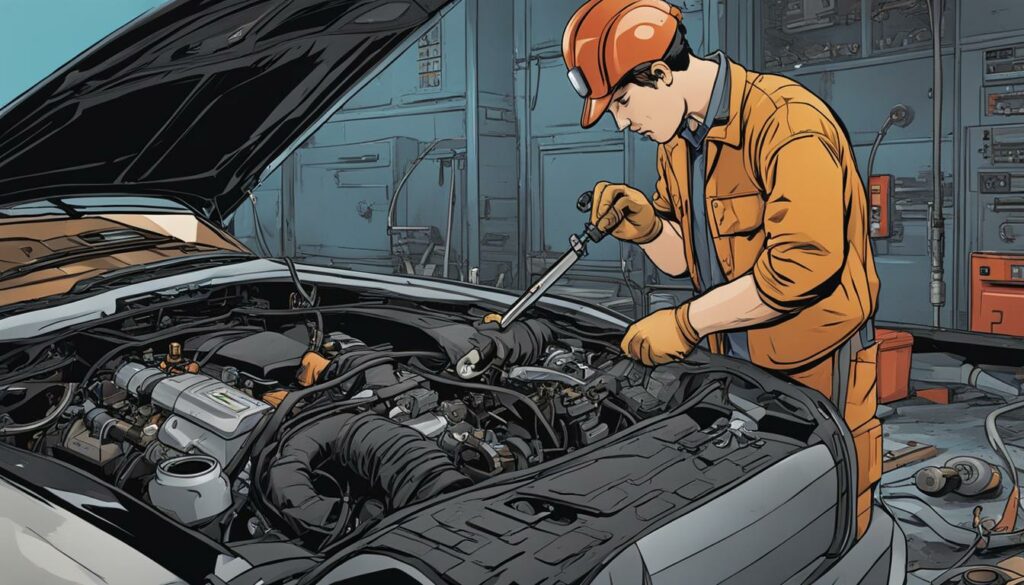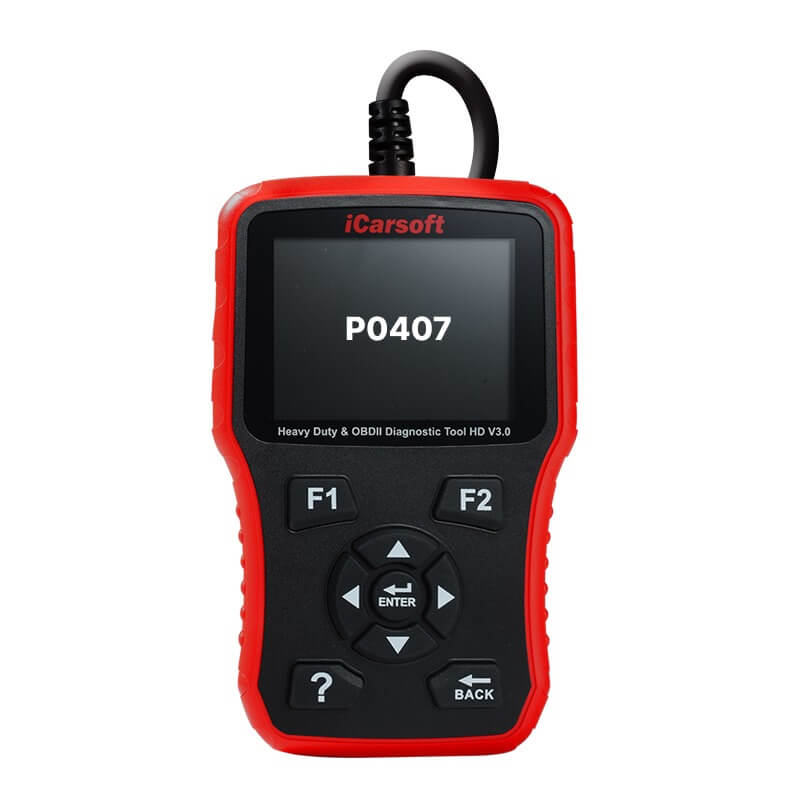P0407 – Exhaust Gas Recirculation Sensor B Circuit Low
POSTED IN pcodes
Welcome to our article on the P0407 error code, which is related to the exhaust gas recirculation (EGR) system in your vehicle. This error code indicates a voltage problem specifically with the EGR sensor circuit, indicating that the signal being sent from the circuit to the engine computer is unusually low. If you have encountered this error, it’s important to understand its causes and how it can be diagnosed and repaired.
When your vehicle’s EGR system is not functioning properly, it can affect the overall performance and emissions. Addressing the P0407 error is crucial to ensure your vehicle operates efficiently and complies with environmental regulations. In this article, we will provide you with a detailed overview of the P0407 error code, including its symptoms, causes, diagnostics, and possible repairs.
Before we dive into the technical details, let’s take a look at an image that illustrates the EGR system and its components:
Key Takeaways:
- The P0407 error code relates to the exhaust gas recirculation (EGR) system
- It signifies a low voltage issue in the EGR sensor circuit
- This error code can be caused by various factors, such as a faulty EGR valve or wiring issues
- Diagnosing and repairing the P0407 error requires professional equipment and expertise
- Seeking assistance from a qualified technician or utilizing online resources can help troubleshoot and resolve the issue
Technical Description of EGR Systems
EGR systems, or exhaust gas recirculation systems, are designed to control and reduce emissions in vehicles. The EGR valve is a PCM controlled valve that allows measured amounts of exhaust gases to pass back into the cylinders to be burned with the air/fuel mixture. This helps to lower combustion temperatures and improve NOx emissions, as exhaust gas is an inert gas that displaces oxygen. EGR systems operate under certain conditions, such as partial throttle or deceleration, and can vary in design and complexity.
By recirculating a portion of the exhaust gases, EGR systems effectively reduce the formation of nitrogen oxides (NOx), one of the primary contributors to air pollution. This is particularly important in vehicles with internal combustion engines, as NOx emissions have a significant environmental impact and contribute to the formation of smog and other harmful pollutants.
Buy tested tuning file for Adblue / EGR / DPF / Adblue off now!
The main component of the EGR system is the EGR valve, which controls the flow of exhaust gases into the combustion chambers. The EGR valve is typically controlled by the powertrain control module (PCM) based on inputs from various sensors, such as throttle position, engine speed, and coolant temperature. When certain operating conditions are met, the PCM opens the EGR valve, allowing a calculated amount of exhaust gases to be redirected back into the cylinders.
The purpose of diverting exhaust gases back into the cylinders is to dilute the incoming air/fuel mixture and reduce the combustion temperature. This helps prevent the formation of nitrogen oxides, which are created at high temperatures during the combustion process. Through the recirculation of exhaust gases, the EGR system effectively reduces NOx emissions, helping vehicles meet emission standards and regulations.
It’s important to note that EGR systems can vary across different vehicle manufacturers and models. The design and complexity of EGR systems may differ based on factors such as engine size, emissions standards, and technological advancements. Some vehicles may have more advanced EGR systems that employ additional components, such as EGR coolers, to further enhance emission control.
| EGR System Components | Description |
|---|---|
| EGR Valve | The main component of the EGR system that controls the flow of exhaust gases into the combustion chambers. |
| EGR Cooler | Reduces the temperature of the recirculated exhaust gases before they enter the combustion chambers. |
| EGR Control Solenoid | Engages and disengages the EGR valve based on signals from the PCM, controlling the flow of exhaust gases. |
| EGR Pressure Sensor | Measures the pressure of the recirculated exhaust gases and provides feedback to the PCM for proper EGR system operation. |
| EGR Position Sensor | Detects the position of the EGR valve and provides feedback to the PCM to ensure accurate control of the EGR system. |
Symptoms of P0407 Error
The P0407 error code related to the exhaust gas recirculation (EGR) system may manifest in various symptoms. It’s essential to recognize these signs to address the issue promptly.
- Check Engine Light: One of the primary indicators of a P0407 error is the illumination of the Check Engine Light on your dashboard. This warning light serves as an early indication that there is a problem within your vehicle’s EGR system.
- Diminished Fuel Mileage: Another symptom commonly associated with a P0407 error is diminished fuel mileage. You might notice that your vehicle is not as fuel-efficient as before, requiring more frequent refueling.
- Hesitation Under Acceleration: Some drivers may experience a slight hesitation or delay in acceleration when a P0407 error is present. This can lead to a less responsive driving experience, affecting overall performance.
While these symptoms may be present in some cases, it’s important to note that many drivers may not notice any significant performance issues with their vehicle. It’s vital to address the P0407 error promptly to prevent any potential complications in the future.

Continue reading to learn more about the causes, diagnosis, and repairs for a P0407 error in the following sections.
Causes of P0407 Error
The P0407 error code can be triggered by several potential causes. These include:
- A faulty EGR valve: The EGR valve plays a crucial role in the EGR system, regulating the flow of exhaust gases. If the valve is faulty or malfunctioning, it can disrupt the normal operation of the system and contribute to the P0407 error.
- A faulty EGR vacuum solenoid: The EGR vacuum solenoid controls the vacuum supply to the EGR valve. When it fails to function correctly, it can lead to improper EGR valve operation and trigger the P0407 error.
- A ground or voltage short in the EGR circuit: Any electrical irregularities, such as a ground or voltage short in the EGR circuit, can affect the signal sent from the EGR sensor to the engine control unit. This disruption can cause the voltage to be unusually low and trigger the P0407 error.
- Bad wiring: Faulty or damaged wiring connections between the engine control unit and the EGR system can also contribute to the P0407 error. Wiring issues can interrupt the proper flow of electrical signals, resulting in low voltage readings and the activation of the error code.
If any of these causes are present, the EGR system may not function as intended, potentially leading to decreased performance and increased emissions. Identifying and resolving these underlying issues is essential for effective troubleshooting and repair.
Diagnosing P0407 Error
To diagnose a P0407 error, you can utilize a professional OBD-II scanner equipped with the latest diagnostic capabilities. This powerful tool allows you to connect to your vehicle’s onboard computer and retrieve valuable information about the EGR system. By monitoring the EGR valve, you can observe its response to feedback signals and identify any anomalies that may indicate a problem.
If the EGR valve fails to respond or operates abnormally, it may be necessary to clean or replace the valve. Carbon buildup or debris can impair the valve’s functionality, leading to voltage issues. Cleaning the valve can help restore its proper operation and address the P0407 error.
Additionally, a multi-meter can be used to test the voltage and ground in the EGR circuit. By measuring the voltage levels at various points and ensuring proper grounding, you can identify any irregularities that might contribute to the P0407 error. This step is crucial in determining if the voltage is within the acceptable range and if the ground connections are secure.
Another essential part of the diagnostic process is testing the EGR solenoid. This component controls the opening and closing of the EGR valve, ensuring the proper flow of exhaust gases. By testing the solenoid’s functionality, you can verify if it is operating correctly, playing a significant role in diagnosing the P0407 error.
The combination of these diagnostic steps, including monitoring the EGR valve, cleaning or replacing the valve if necessary, testing the voltage and ground, and testing the solenoid, can help you pinpoint the exact cause of the P0407 error. By identifying and addressing the root issue, you can effectively resolve the error and restore your vehicle’s optimal performance.
Repairs for P0407 Error
When encountering a P0407 error related to the exhaust gas recirculation (EGR) system, there are several common repairs that can address this issue.
One of the first steps in troubleshooting the P0407 error is to clean the EGR valve. The valve may become contaminated with carbon deposits or debris that cause it to stick. Cleaning the valve can help restore proper functionality and resolve the error. Here is a step-by-step guide to cleaning the EGR valve:
- Disconnect the negative terminal of the battery to ensure safety during the cleaning process.
- Locate the EGR valve, which is typically found near the intake manifold or throttle body.
- Remove any electrical connectors or vacuum lines attached to the EGR valve.
- Using an appropriate EGR cleaner, spray the valve thoroughly to dissolve and remove any carbon buildup.
- Allow the cleaner to sit on the valve for the recommended time specified by the product manufacturer.
- Gently scrub the valve with a soft-bristle brush to aid in removing stubborn deposits.
- Rinse the valve with clean water to remove any remaining cleaner and debris.
- Reinstall the EGR valve, reconnect any electrical connectors or vacuum lines, and reattach the negative terminal of the battery.
In some cases, the P0407 error may be caused by wiring issues. Faulty or damaged wiring can disrupt the flow of signals to and from the EGR system. To address wiring problems:
- Inspect the wiring harness for any visible signs of damage, such as frayed wires or loose connections.
- If any issues are found, repair or replace the affected wiring as necessary.
- Ensure all connections are secure and properly seated.
If cleaning the EGR valve and repairing the wiring does not resolve the P0407 error, it may be necessary to replace the EGR valve itself. A faulty EGR valve can cause the voltage to be unusually low, triggering the error code. Here is a general guide to replacing the EGR valve:
- Disconnect the negative terminal of the battery before starting the replacement process.
- Locate the EGR valve and identify any mounting bolts or screws holding it in place.
- Remove the bolts or screws and carefully disconnect any electrical or vacuum connections attached to the valve.
- Take out the old EGR valve and set it aside.
- Install the new EGR valve, ensuring it is properly aligned and seated.
- Reattach any electrical or vacuum connections.
- Secure the new EGR valve in place by tightening the mounting bolts or screws.
- Reconnect the negative terminal of the battery.
Remember to test and repair the least expensive components first, such as wiring and the solenoid, before considering EGR valve replacement. This approach can potentially save time and money.
Estimated Cost of Repairs
The cost of repairs for a P0407 error can vary depending on the specific vehicle make and model, as well as labor rates in your area. Here is a rough estimate of the costs associated with each repair:
| Repair | Estimated Cost |
|---|---|
| Cleaning the EGR Valve | $20 – $50 (cost of EGR cleaner) |
| Repairing Wiring | $50 – $150 (cost of replacement wiring) |
| Replacing the EGR Valve | $100 – $500 (cost of new EGR valve) |
Please note that these estimates are for informational purposes only and may not reflect the exact costs you may incur during the repair process. It is always recommended to consult with a qualified mechanic or automotive technician for an accurate assessment of repair costs.

Related EGR Codes and Discussions
In addition to the P0407 error code, there are several other related EGR codes that can indicate issues with the EGR system. These codes often provide valuable insights into the specific problem and help guide the troubleshooting process. Here are some of the most common related EGR codes:
- P0400 – Exhaust Gas Recirculation Flow Malfunction
- P0401 – Exhaust Gas Recirculation Flow Insufficient Detected
- P0402 – Exhaust Gas Recirculation Flow Excessive Detected
- P0403 – Exhaust Gas Recirculation Circuit Malfunction
- P0404 – Exhaust Gas Recirculation Circuit Range/Performance
- P0405 – Exhaust Gas Recirculation Sensor A Circuit Low
- P0406 – Exhaust Gas Recirculation Sensor A Circuit High
- P0408 – Exhaust Gas Recirculation Sensor A Circuit High
- P0409 – Exhaust Gas Recirculation Sensor B Circuit Intermittent
Each of these codes is associated with a different aspect of the EGR system, providing valuable clues for diagnosis and repair. It is essential to consider all relevant codes when troubleshooting EGR system issues for a comprehensive solution.
For further discussion and assistance with the P0407 error code or any other related EGR codes, participating in online car repair forums can be incredibly helpful. These forums offer a wealth of knowledge and practical experience from fellow car enthusiasts and professionals who have encountered similar issues. By sharing your specific problem and engaging in discussions, you can gain valuable insights, tips, and step-by-step guidance to resolve your EGR system concerns.
Comparative Analysis of Related EGR Codes
| EGR Code | Description |
|---|---|
| P0400 | Exhaust Gas Recirculation Flow Malfunction |
| P0401 | Exhaust Gas Recirculation Flow Insufficient Detected |
| P0402 | Exhaust Gas Recirculation Flow Excessive Detected |
| P0403 | Exhaust Gas Recirculation Circuit Malfunction |
| P0404 | Exhaust Gas Recirculation Circuit Range/Performance |
| P0405 | Exhaust Gas Recirculation Sensor A Circuit Low |
| P0406 | Exhaust Gas Recirculation Sensor A Circuit High |
| P0408 | Exhaust Gas Recirculation Sensor A Circuit High |
| P0409 | Exhaust Gas Recirculation Sensor B Circuit Intermittent |
Understanding the differences between these codes can provide important insights into the specific nature of EGR system issues, aiding in the diagnosis and repair process. By comparing and analyzing the various codes, you can gain a deeper understanding of how the EGR system operates and how different components and circuits may be affected.
Conclusion
In conclusion, the P0407 error code related to the exhaust gas recirculation (EGR) system can be a frustrating issue for vehicle owners. However, by following the appropriate troubleshooting steps, drivers can diagnose and repair the problem. It is important to identify the underlying cause of the error, such as a faulty EGR valve, wiring problem, or other component malfunction.
Once the cause is determined, drivers can take the necessary actions to address the issue. This may involve cleaning or replacing the EGR valve, repairing any faulty wiring, or replacing other components as needed. It is recommended to start with the least expensive repairs first, to rule out any easy fixes before moving on to more complex solutions.
If you are unsure about the diagnosis or repair process, seeking professional assistance or utilizing online resources can be helpful. Online car repair forums and communities can provide valuable guidance and support from experienced individuals who have dealt with similar issues in the past. Remember, with the right knowledge and resources, you can successfully resolve the P0407 error and ensure the proper functioning of your EGR system.
FAQ
What does the P0407 error code mean?
The P0407 error code indicates a voltage problem with the exhaust gas recirculation (EGR) system. It specifically points to a low voltage signal being sent from the EGR sensor circuit to the engine computer.
What is an EGR system?
An EGR system, or exhaust gas recirculation system, is designed to control and reduce emissions in vehicles. It consists of an EGR valve that allows measured amounts of exhaust gases to pass back into the cylinders to be burned with the air/fuel mixture, lowering combustion temperatures and improving emissions.
What are the symptoms of a P0407 error?
Symptoms may include the illumination of the Check Engine Light, diminished fuel mileage, and slight hesitation under acceleration. However, in most cases, drivers will not notice any significant performance issues with their vehicle.
What are the common causes of a P0407 error?
The common causes of a P0407 error include a faulty EGR valve, faulty EGR vacuum solenoid, ground or voltage short in the EGR circuit, or bad wiring from the engine control unit to the EGR system.
How is a P0407 error diagnosed?
A professional OBD-II scanner can be used to monitor the EGR valve and test its response. Additionally, a multi-meter can be used to test the voltage and ground in the EGR circuit, and the EGR solenoid can be tested for proper functioning.
What repairs are needed for a P0407 error?
Common repairs include cleaning the EGR valve to remove any carbon or debris, repairing any wiring issues, and potentially replacing the EGR valve if it is determined to be faulty.
Are there any related EGR codes?
Yes, other related EGR codes include P0400, P0401, P0402, P0403, P0404, P0405, P0406, P0408, and P0409. Each of these codes indicates different issues with the EGR system.
How can I find further discussion and assistance with the P0407 error code?
You can participate in online car repair forums where you can find additional guidance and support for addressing the P0407 error.
How can I troubleshoot and repair the P0407 error?
By identifying the cause of the error, such as a faulty EGR valve or wiring problem, you can take the necessary steps to diagnose and repair the issue. Seeking professional assistance or utilizing online resources can provide further guidance in troubleshooting and resolving the P0407 error.


